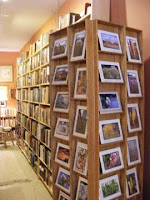
Junior high, high school, college, graduate school—that’s a lot of years of assigned reading, so while I love book discussions, sometimes the “assignment” nature of a book club or reading group crosses swords with the rebel in me who says, “No more assigned books! I’ll read whatever I want to read!” I was comforted to hear our township librarian say she sometimes feels the same way.
It helps me that two of the groups I’m part of are very small, and none of the groups meets every month of the year. The intrepid band that formed to read
Ulysses is currently reading
Anna Karenina together, a much less daunting assignment. It’s long but goes along at a good clip, and we're meeting every other week to discuss two (of the eight) parts at each meeting. Another tiny group (only five women) probably won’t meet again until May, and only two of us have finished the book our May hostess suggested,
A Suitable Boy, which may be the longest book I’ve ever read.
The book discussion group that meets at the township library is open to anyone, and different people drop in and out as the spirit moves them. This month’s book is
Cutting for Stone, which I have not read (though I read and loved Verghese’s first book, a memoir entitled
My Own Country), but I’ll probably go to the meeting and listen to what others have to say. I asked, and the librarian told me I would be welcome without having read the book. That took the pressure off. Bookseller and librarian, we feel the weight of our reading responsibilities keenly, but we can no more read everything than can anyone else, and we have to read selectively, difficult as that sometimes is.
Then there are the tasks I assign myself. A general one is to list every book I read here on the blog but only books I read from beginning to end, which can lead to a feeling that any book I begin I
must read in its entirety. But no, that doesn’t work. Halfway through
The Book of Salt, for example, I rebelled, feeling like a hostage to the character’s interior life. He would say that he’d met a man on a bridge in Paris, for example, and I wanted to know
which bridge, but he wouldn’t tell me! I wanted to be
in Paris, not a prisoner in this young man’s head! As you see, this is not a criticism of the novel at all. It was just not where I wanted to be. Now I’m some chapters into
An Accidental Autobiography, by Barbara Grizutti Harrison, and for a while I thought I wouldn't keep going, but so far, as I reach the end of each chapter, I begin the next. We’ll see how long Ms. Harrison and I continue together. The punctuation drives me a little nuts, but her way with words and her understanding of memory as neither chronological nor hierarchical has me captivated. For now.
And then there is Dante, lying neglected but not completely forgotten on the top of my dresser. It isn’t that I lost interest in the story, but the translation wasn’t doing it for me. Where is the lyricism I expected of the poetry? Whose translation should I be reading instead? Well, maybe I will, and maybe I won’t! That “should” word in my own question has already roused the rebel spirit who sleeps with one eye open!
What a coincidence! Writing of my neglect of Dante, I went to visit Lifetime Reader's blog and found a topic that made me smile, "
Books We Have Hated." Are there books you were assigned to read and absolutely hated? Do you still hate them?




















































